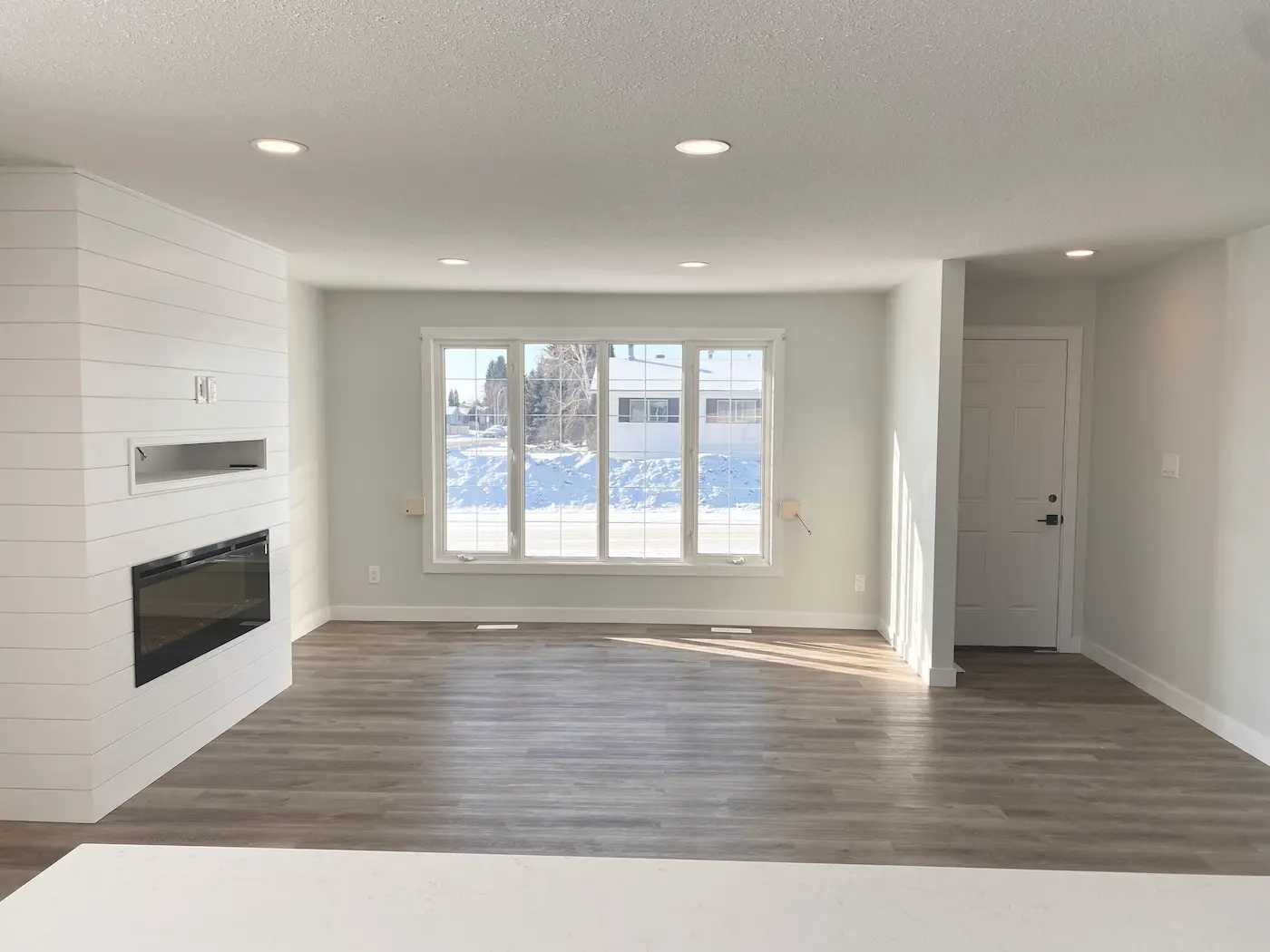After two decades of transforming Edmonton properties, I’ve learned that the difference between a home that languishes on the market and one that sparks bidding wars often comes down to strategic pre-listing renovations. Let me share everything you need to know about preparing your property for a successful sale.
What Are Pre-Listing Renovations?
Pre-listing renovations are strategic improvements made to a property before it hits the market. Unlike renovations for personal enjoyment, these are laser-focused on maximizing appeal to buyers and generating the highest possible return on investment.
The goal isn’t perfection—it’s marketability. Smart pre-listing renovations create that crucial “wow factor” that makes buyers fall in love at first sight.
Why Pre-Listing Renovations Matter More Than Ever
The Psychology of Buyers
Today’s buyers are overwhelmed with choices and short on time. When they walk into a home, they’re not seeing potential—they’re seeing work. Every outdated fixture, worn floor, or tired paint job translates to time, money, and hassle in their minds.
Move-in ready homes eliminate these mental barriers, allowing buyers to envision their future instead of a to-do list.
The Numbers Don’t Lie
Recent Edmonton market data reveals:
- Renovated homes receive 3x more showings in the first week
- Significantly reduced time on market for move-in ready properties
- Average price premium of 15-20% over comparable unrenovated homes
- Kitchen and bathroom renovations deliver 75-100% ROI according to industry data
- The majority of renovated homes receive multiple offers
Strategic Renovation Planning
The 80/20 Rule
Focus on the 20% of renovations that deliver 80% of the impact. In Edmonton’s market, this typically means:
- Kitchen updates (even minor ones transform the feel)
- Main bathroom renovation
- Flooring replacement in main areas
- Fresh paint throughout
- Curb appeal improvements
Budget Guidelines
As a rule of thumb, invest 5-10% of your home’s expected sale price in pre-listing renovations. For a $400,000 home, that’s $20,000-$40,000 strategically deployed.
Budget allocation example:
- Kitchen updates: 40%
- Bathroom renovation: 25%
- Flooring: 20%
- Paint and cosmetics: 10%
- Curb appeal: 5%
Room-by-Room Renovation Priorities
Kitchen: The Heart of the Sale
Kitchens sell homes—it’s that simple. But you don’t need a $50,000 renovation to make an impact.
High-impact kitchen updates:
- Cabinet refacing or painting (not full replacement)
- New countertops (quartz is the current favorite)
- Modern backsplash
- Updated lighting fixtures
- New hardware (amazing what $200 in handles can do)
- Stainless steel appliances (or appliance panels for consistency)
Pro tip: If the layout works, keep it. Moving plumbing and electrical drives costs up quickly.
Bathrooms: Small Spaces, Big Impact
Bathrooms are where buyers imagine starting and ending their days. Dated bathrooms are deal-breakers.
Essential bathroom updates:
- Modern vanity with ample storage
- Updated fixtures in consistent finish
- New toilet (comfort height preferred)
- Fresh tile or luxury vinyl flooring
- Good lighting (nobody wants to get ready in a cave)
- Frameless glass shower doors (instant modern feel)
Living Spaces: Creating Flow
Living area priorities:
- Consistent flooring throughout main level
- Fresh, neutral paint (goodbye feature walls)
- Updated light fixtures
- Modernized fireplace surrounds
- Removed dated elements (popcorn ceilings, wood paneling)
Bedrooms: Simple but Important
Bedroom basics:
- Fresh paint in calming neutrals
- Quality carpet or continuing hardwood
- Updated closet systems
- Modern lighting
- Clean, functioning windows
Basements: Hidden Value
In Edmonton, finished basements significantly impact value due to our climate.
Basement considerations:
- Proper moisture control is non-negotiable
- Legal bedrooms with egress windows
- Bathroom addition (huge value add)
- Open recreation space
- Good lighting to combat the “basement feel”
Exterior: First Impressions Matter
Never underestimate curb appeal. Buyers often decide whether to enter based on exterior appearance.
Exterior priorities:
- Fresh paint or siding repair
- New garage doors (surprisingly high ROI)
- Landscaping cleanup and enhancement
- Modern house numbers and lighting
- Power washing everything
- Deck/fence repairs
Timing Your Renovations
The Ideal Timeline
12 weeks before listing:
- Consult with your realtor
- Get renovation quotes
- Finalize renovation scope
8-10 weeks before listing:
- Begin renovations
- Start with longest lead-time items
2-4 weeks before listing:
- Complete all work
- Professional cleaning
- Staging consultation
1 week before listing:
- Professional photography
- Final touches
Avoiding Common Timing Mistakes
- Don’t start renovations without a clear timeline
- Build in buffer time (renovations always take longer)
- Coordinate trades efficiently to avoid delays
- Have a backup plan for unexpected issues
Working with Professionals
Choosing the Right Contractor
Look for contractors who:
- Specialize in pre-sale renovations
- Understand ROI-focused improvements
- Can work within tight timelines
- Have proven track records
- Offer warranties on their work
The Realtor Partnership
Your realtor should be involved from day one. They know:
- What buyers in your area want
- Which improvements offer the best ROI
- How to price post-renovation
- Market timing considerations
Innovative Financing Options
Many homeowners are now using programs where renovations are completed with no upfront costs, paying only from sale proceeds. This removes the financial barrier to strategic improvements.
Mistakes to Avoid
Over-Personalization
Your style might not be everyone’s style. Stick to broad-appeal choices.
Over-Improvement
Don’t create the most expensive home on the block—there’s a ceiling on returns.
Cutting Corners
Buyers (and inspectors) will notice shoddy work. Do it right or don’t do it.
Ignoring the Neighborhood
Renovations should align with area expectations and price points.
DIY Everything
While some tasks are DIY-friendly, professional work typically yields better ROI.
The Cost of NOT Renovating
Consider what happens without pre-listing renovations:
- Longer time on market (accumulating carrying costs)
- Price reductions
- Fewer showings
- Conditional offers with inspection clauses
- Buyers demanding credits for updates
- Ultimate sale price below potential
When you factor in these costs, strategic renovations often pay for themselves—and then some.
Success Stories
Delwood Transformation: $35,000 in renovations led to a sale $85,000 over comparable unrenovated homes. Time on market: 8 days with multiple offers.
Kilkenny Revival: $40,000 investment focusing on kitchen and bathrooms. Result: Sold in 6 days for $52,000 over asking.
Ottewell Update: $25,000 in strategic updates. Property sold 45 days faster than neighborhood average for 18% more than initial market evaluation.
Your Action Plan
- Get a professional evaluation: Understand your home’s current market position
- Identify strategic improvements: Focus on high-ROI renovations
- Create a realistic budget: Factor in contingencies
- Build your team: Realtor, contractor, designer
- Execute efficiently: Time is money in real estate
- Market strategically: Highlight improvements in listing
Conclusion
Pre-listing renovations aren’t an expense—they’re an investment in your property’s market potential. When done strategically, they transform your home from just another listing into the property everyone wants.
The Edmonton market rewards move-in ready homes with faster sales and premium prices. By focusing on strategic improvements that resonate with buyers, you’re not just selling a house—you’re selling a dream.
Ready to unlock your property’s full potential? The difference between an okay sale and an exceptional one often comes down to preparation. Make sure you’re on the right side of that equation.
Contact us to discover how strategic pre-listing renovations can transform your selling experience and maximize your property’s value.


